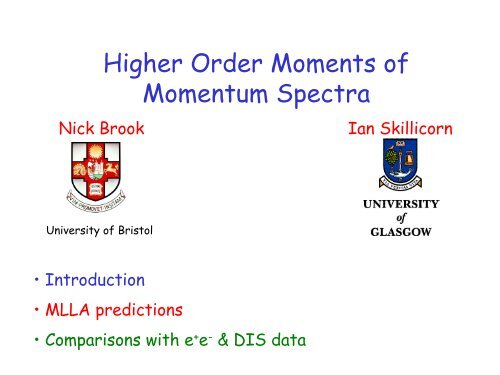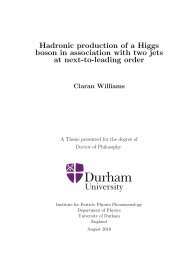Higher Order Moments of Momentum Spectra
Higher Order Moments of Momentum Spectra
Higher Order Moments of Momentum Spectra
You also want an ePaper? Increase the reach of your titles
YUMPU automatically turns print PDFs into web optimized ePapers that Google loves.
<strong>Higher</strong> <strong>Order</strong> <strong>Moments</strong> <strong>of</strong><strong>Momentum</strong> <strong>Spectra</strong>Nick Brook Ian SkillicornUniversity <strong>of</strong> Bristol•Introduction• MLLA predictions• Comparisons with e + e - & DIS data
Fragmentation FunctionsD(ξ,Q,Λ) not calculable in pQCDxp pp= =2p QmaxBUT know how to evolve in Q 2⎛ξ = log⎜1⎝x p⎟⎠⎞For e + e -: Q = √sFor DIS: Q is the virtuality <strong>of</strong> the exchanged photon andp is measured in the current region <strong>of</strong> the Breit frame(where p max is Q/2)
The Breit Frame`Brickwall’ framespacea)Electron-positron Annihilatione +e -Z/ γqqDIS in the Breit Framee - e -Z/ γqqqtimePhase space for e + e -annihilation evolveswith Q/2 = √s/2pTb)qe -e +qqqqqe -e -pLCurrent hemisphere<strong>of</strong> Breit frameevolves as Q/2c)-Q/2pTQ/2pLpT-Q/2 Q/2(1-x)Q/2xpLCurrent region ≡ e + e -annihilationCURRENTTARGET
<strong>Moments</strong> <strong>of</strong> ξ dist bnMLLA theory assumesenergy spectra - exptmeasure momentaKhoze, Lupia & Ochssuggested (Phys LettB386 1996 451) the cut<strong>of</strong>fin evolution can berelated to an effectivemass, m eff , <strong>of</strong> the hadrons1 1 1( ξ Q,Λ) ∝ exp k − sδ− ( 2 + k)MLLA predictions forthe Q evolution <strong>of</strong>moments (Dokshitzer etal, Int J Mod Phys A71992, 1875.)Fong & Webbersuggested region aroundpeak can be described bya distorted GaussianExtract moments fromfits to MLLA theoreticalspectra and data in aconsistent manner(PLB 479 2000 173 & PLB 497 2001 55)[ ]2 1 3 1 4δ + sδkD , + δwhere8δ =2( ξ −ξ)σ4624
Scaled <strong>Momentum</strong> Distributions, ξ pFollowing the approach <strong>of</strong> Khoze et al., can relate a cut<strong>of</strong>f,Q 0 , in the parton evolution to the mass <strong>of</strong> hadrons,m eff , and the MLLA spectra to expt. spectra:1Ndnhdξp∝pEhhD(ξ,Q,Λ)whereξ =⎛log⎜⎜⎝Q2eQ−2ξ p 2+ Q0⎞⎟⎟⎠&E2h= ph+Q20
MLLA <strong>Spectra</strong>•Typical hump back shapewith dependence on energy,Q 0 & ΛIntroduce m eff•Changes in RHS side <strong>of</strong>distorted Gaussian byintroducing m eff term (i.e.momentum getting smaller)•No longer displays usualtruncation at large ξE h = p hE h ≠ p h
MLLA <strong>Moments</strong>•Marked differencebetween Dokshitzer et al &fit to MLLA spectra(calculating moments overwhole range <strong>of</strong> spectra givesame answer as analyticcalculation)•Important moments arecalculated/extracted inconsistent manner!!•Different assumption infor small ξ account fordifference between F&Wand Dokshitzer et al ??•As Q↑ all predictionsconvergefit to MLLA spectra; Dokshitzer et alanalytic; Fong & Webber analytic
<strong>Moments</strong> <strong>of</strong> <strong>Spectra</strong> &e + e - Data<strong>Moments</strong> extracted from fit<strong>of</strong> distorted Gaussian to dataBUT also to theory•MLLA-0 gives reasonabledescription <strong>of</strong> mean &skewness•MLLA-0: σ is smaller & moreplatykurtic than data•MLLA-M gives poorerdescription <strong>of</strong> all varaibles atlow E CM•MLLA-M approaches MLLA-0& data at high E CMMLLA-0 (no m eff term - Q 0 = Λ)--- MLLA-M (with m eff term - m eff = Q 0 = Λ)
<strong>Moments</strong> <strong>of</strong> <strong>Spectra</strong> &DIS Data<strong>Moments</strong> extracted from fit<strong>of</strong> distorted Gaussian to data& theory curves•m eff allowed to be freeparameter in fits to data•MLLA-M & MLLA-0 bracketthe data. At high Q bothapproach the data•Fit to DIS data Λ=280 MeV &m eff = 230 MeV. Reasonabledescription <strong>of</strong> all variablesexcept mean ( and peakposition)ξσsmax= ξ + 1( ( ) )12 21−+ sQ 0 = Λ ≠ m eff
Summary•Care needs to be taken in choosing the range <strong>of</strong> ξ when comparing data& theory•Wide discrepancy in higher order moments (skewness & kurtosis)between MLLA-M & MLLA-0 and data. Predictions converge as Q↑•Limiting spectra preferred over truncated spectra (Q 0 ≠ Λ) incomparison with data•m eff has a large effect at all but highest Q•MLLA gives reasonable agreement with higher moments <strong>of</strong> data forfitted values <strong>of</strong> Λ and m eff
















